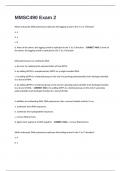Mmsc490 exam - Study guides, Class notes & Summaries
Looking for the best study guides, study notes and summaries about Mmsc490 exam? On this page you'll find 60 study documents about Mmsc490 exam.
Page 2 out of 60 results
Sort by

-
MMSC490 Exam 1 Questions and Answers 2024
- Exam (elaborations) • 16 pages • 2024
-
- $12.49
- + learn more
MMSC490 Exam 1 Questions and Answers 2024 The simplicity and clarity of Caenorhabditis elegans allowed researchers to - Answer- Identify the genes in differentiation of each cell type The diffraction limited resolving power of a standard light microscope is approximately - Answer-0.2 Om Chloroplasts are thought to have originated from endosymbiosis of ___ by large host cell. - Answer-Photosynthetic eubacteria such as cyanobacteria The eukaryotic nucleus contains ___ DNA molecule (s). - An...
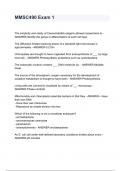
-
MMSC490 Exam 1 questions and answers
- Exam (elaborations) • 15 pages • 2024
-
- $7.99
- + learn more
The simplicity and clarity of Caenorhabditis elegans allowed researchers to - ANSWER-Identify the genes in differentiation of each cell type The diffraction limited resolving power of a standard light microscope is approximately - ANSWER-0.2 Om Chloroplasts are thought to have originated from endosymbiosis of ___ by large host cell. - ANSWER-Photosynthetic eubacteria such as cyanobacteria The eukaryotic nucleus contains ___ DNA molecule (s). - ANSWER-Multiple linear The source of the atm...
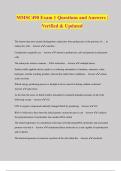
-
MMSC490 Exam 1 Questions and Answers | Verified & Updated
- Exam (elaborations) • 14 pages • 2024
- Available in package deal
-
- $12.49
- + learn more
MMSC490 Exam 1 Questions and Answers | Verified & Updated The feature that most clearly distinguishes eukaryotes from prokaryotes is the presence of..... in eukaryotic cells - Answer ️️ -a nucleus Cytoplasmic organelles are - Answer ️️ -absent in prokaryotic cells and present in eukaryotic cells The eukaryotic nucleus contains.... DNA molecules - Answer ️️ -multiple linear Stanley miller applied electric sparks to a reducing atmosphere of methane, ammonia, water, hydrogen, an...
MMSC490 Exam 1 Questions and Answers
MMSC490 Exam 2 Questions And Answers MMSC490 Exam 2 Questions And Answers MMSC490 Exam 2 Questions And Answers
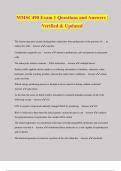
-
MMSC490 Exam 1 Questions and Answers | Verified & Updated
- Exam (elaborations) • 14 pages • 2024
- Available in package deal
-
- $12.49
- + learn more
MMSC490 Exam 1 Questions and Answers | Verified & Updated The feature that most clearly distinguishes eukaryotes from prokaryotes is the presence of..... in eukaryotic cells - Answer ️️ -a nucleus Cytoplasmic organelles are - Answer ️️ -absent in prokaryotic cells and present in eukaryotic cells The eukaryotic nucleus contains.... DNA molecules - Answer ️️ -multiple linear Stanley miller applied electric sparks to a reducing atmosphere of methane, ammonia, water, hydrogen, an...
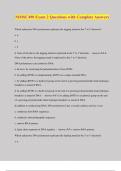
-
MMSC490 Exam 2 Questions with Complete Answers
- Exam (elaborations) • 57 pages • 2024
- Available in package deal
-
- $13.49
- + learn more
MMSC490 Exam 2 Questions with Complete Answers Which eukaryotic DNA polymerase replicates the lagging strand in the 3ʹ to 5ʹ direction? a. α b. γ c. δ d. None of the above; the lagging strand is replicated in the 5ʹ to 3ʹ direction. - Answer ️️ -d. None of the above; the lagging strand is replicated in the 5ʹ to 3ʹ direction. DNA polymerases can synthesize DNA: a. de novo, by catalyzing the polymerization of free dNTPs. b. by adding dNTPs to complementary dNTPs on a single-...
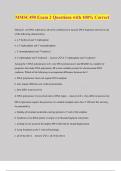
-
MMSC490 Exam 2 Questions with 100% Correct
- Exam (elaborations) • 28 pages • 2024
- Available in package deal
-
- $12.49
- + learn more
Although E. coli DNA polymerase I is not a chromosomal DNA replicase, it participates in DNA replication. What is its function? a. synthesizes Okazaki fragments b. replaces RNA primer with DNA c. unwinds the double helix d. synthesizes an RNA primer e. connects 3' end of one okazaki fragment with the 5' end of another - Answer ️️ -b. replaces RNA primer with DNA In a replication fork, how do leading and lagging strands differ? a. lagging strand is subject to more error and require...
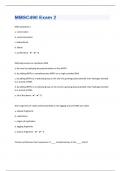
-
MMSC490 Exam 2|171 Exam Study Guide Questions And Answers|100% Correct |2024|39 Pages
- Exam (elaborations) • 39 pages • 2024
- Available in package deal
-
- $8.49
- + learn more
DNA replication is a. conservative b. semiconservative c. bidirectional d. liberal e. proliferative - ️️B DNA polymerase can synthesise DNA a. de novo by catalysing the polymerisation of free dNTPs b. by adding dNTPs to complementary dNTPs on a single stranded DNA c. by adding dNTPs to a hydroxyl group on the end of a growing polynucleotide chain hydrogen bonded to a strands of RNA d. by adding dNTPs to a hydroxyl group on the end of a growing polynucleotide chain hydrogen bonded...
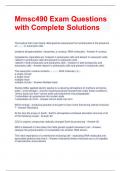
-
Mmsc490 Exam Questions with Complete Solutions
- Exam (elaborations) • 9 pages • 2024
-
Available in package deal
-
- $13.99
- + learn more
Mmsc490 Exam Questions with Complete Solutions The feature that most clearly distinguishes eukaryotes from prokaryotes is the presence of ......... in eukaryotic cells oxidative phosphorylation, ribosomes, a nucleus, RNA molecules - Answer-A nucleus Cytoplasmic organelles are *present in prokaryotic cells and absent in eukaryotic cells . *absent in prokaryotic cells and present in eukaryotic cells . *absent in both prokaryotic and eukaryotic cells . *present in both prokaryotic and ...

How did he do that? By selling his study resources on Stuvia. Try it yourself! Discover all about earning on Stuvia


